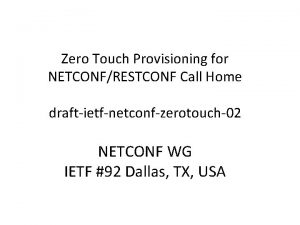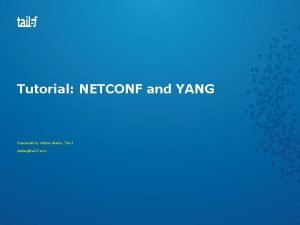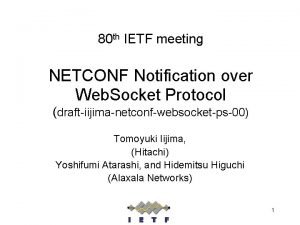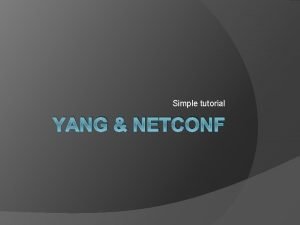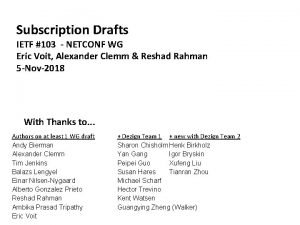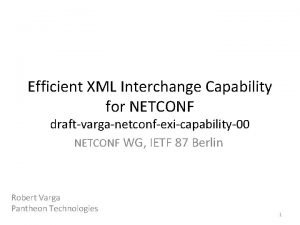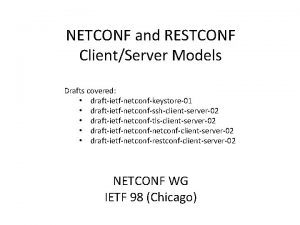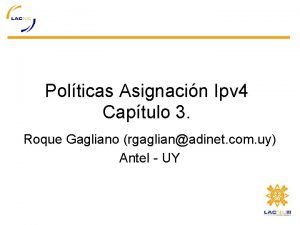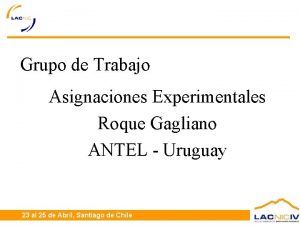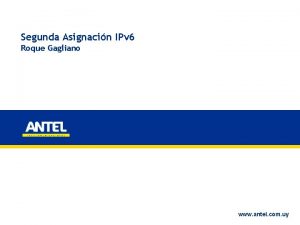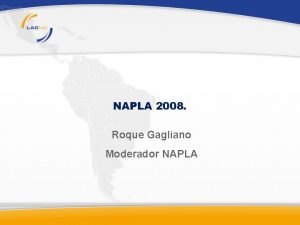NETCONF and RESTCONF Roque Gagliano Origins of NETCONF










































- Slides: 42

NETCONF and RESTCONF Roque Gagliano

Origins of NETCONF and YANG (the Beginning) • Several meetings at events in 2001 (NANOG-22, RIPE-40, LISA-XV, IETF 52) • Operators expressing opinion that the developments in IETF do not really address requirements configuration management. • June of 2002, the Internet Architecture Board (IAB) held invitational workshop on Network Management [RFC 3535] to • Identify a list of technologies relevant for network management with their strengths and weaknesses • Identify the most important operator needs. 2

RFC 3535: Results from IAB Workshop

RFC 3535: Operator requirements for a new configuration protocol • • • • Ease of use Separation between configuration and state data Ability to compare across-devices, across-vendors Service and network management, not device management Network-wide transactions Devices figure out order of commands(ACID…anyways) No unnecessarily changes Backup/restore configuration Validation of configuration Standardized data models Support for multiple configuraiton sets Delayed, orchestrated activation Role-based access control

Implications of RFC 3535, legacy situation OSS NMS EMS Cost and complexity Information leakage • Lack of atomicity • Ordering problem Cost

Implications of RFC 3535, with transactions OSS NMS EMS Reduced Cost and complexity Require transactions Cost/ Value

Best Practices Coming Together CLI Best Practices Operator Requirements SNMP Experience NETCONF and YANG 7

YANG – A Data Modeling Language for Networking • Human readable, and easy to learn representation • Hierarchical configuration data models Why you should care: YANG is a full, formal contract language with rich syntax and semantics to build applications on • Reusable types and groupings (structured types) • Extensibility through augmentation mechanisms • Supports definition of operations (RPCs) • Formal constraints for configuration validation • Data modularity through modules and sub-modules • Well defined versioning rules 8

YANG standard models • Base document: RFC 6020 • YANG + NETCONF: RFC 6241 • IETF approved documents: • • Common types (RFC 6991) IANA Interface types (RFC 7224) Interface management (RFC 7223) IP management (RFC 7277) System management (RFC 7317) IPFIX configuration (RFC 6728) SNMP configuration (RFC 7407) • In the making: • • • Syslog configuration ACL configuration Network topology, L 3 topology BGP, OSPF Netconf monitoring, Netconf access control (NACM) L 2 VPN, PIM, MPLS-LDP, • Standard content library still small but rapidly growing • Most foundational models are in place • Complement “top-down” definitions with models that are synthetically generated (think Google Translate)

NETCONF Protocol Introduction

NETCONF – A Protocol to Manipulate Configuration • • • IETF network management protocol Distinction between configuration and state data Multiple configuration data stores (candidate, running, startup) Configuration change validations Why you should care: Configuration change transactions NETCONF provides the Selective data retrieval with filtering fundamental programming Streaming and playback of event notifications features for comfortable and robust automation of network Extensible remote procedure call mechanism services NETCONF Notifications support New work on pushing pub/subs to expand NETCONF into telemetry 11

Self-service portal Customers & accounts Call center Order capture engine Product configuration Products & Price Catalog Order Management CPQ Service Fulfillment and related parts of OSS/BSS (except Service Assurance) Customer care Knowledge base Installed assets Field Service provisioning Supply Chain Service activation Resource inventory Billing Contracts & SLAs

What is NETCONF? NETCONF (Network Configuration Protocol) is an IETF configuration management protocol not only config access, also operational state data NETCONF uses XML (as you are going to see) Why NETCONF? Separates Config and Operational Data Accessible Format Error Checking Backup/Restore Capability Human and Machine Friendly RFC 3535 Lots of Tooling Next-Gen Configuration Management Requirements Easy to Use

What is an ACID transaction • Atomicity: • Transactions are indivisible, all-or-nothing • Consistency: • Transactions are all-at-once • There is no internal order inside a transaction, it is a set of changes, not a sequence • Independence: • Parallel transactions do not interfere with each other • Transactions appear to happen always-in-sequence • Durability • Committed data always-sticks, i. e. remains in the system even in the case of a failover, power failure, restart, etc

NETCONF IETF Standard Information V 1. 0 V 1. 1 Extension RFC 6535 Background and Requirements RFC 6241 1. 1 Base NETCONF Protocol RFC 5277 Notifications RFC 4741 1. 0 Base NETCONF Protocol RFC 6242 NETCONF over SSH RFC 5717 Partial Locking RFC 4742 NETCONF over SSH RFC 6243 With defaults RFC 6244 NETCONF + YANG Architectural Overview

NETCONF Protocol Stack Client initiated session Content Server SSH Client Operations Reason: Messages Transport • • Connection-oriented (TCP) Authenticated Reliable Secure

NETCONF Protocol Stack <rpc> Content Operations <rpcreply> Client NETCONF Messages: Messages Transport • Remote Procedure Call (RPC) RPC Client’s Request Methods: • • Controller NMS Script Manual Server

NETCONF Protocol Stack OPERATION DESCRIPTION <get-config> Retrieve data from the running configuration <get> Retrieve running configuration or device statistic <edit-config> Modify a configuration database - operation = merge (default), delete, create, replace, remove - test-option (: validate), error-option <copy-config> Copy a configuration database <delete-config> Delete a configuration database <commit> Commit candidate configuration to the running db <lock>/<unlock> Lock or unlock a configuration datastore system <close-session> Terminate this session <kill-session> Force Termination of session <createsubscription> event notification subscription <notification> asynchronously message from server to client when an event of interest has occurred Content Operations Messages Transport

NETCONF Protocol Stack Content Operations Messages Transport <? xml version="1. 0" encoding="UTF-8"? > <hello xmlns="urn: ietf: params: xml: ns: netconf: base: 1. 0"> <capabilities> <capability> urn: ietf: params: netconf: base: 1. 0 </capability> <capability> urn: ietf: params: netconf: capability: candidate: 1. 0 </capability> <capability> urn: ietf: params: netconf: capability: notification: 1. 0 </capability> </capabilities> <session-id>285212672</session-id> </hello> ]]>]]>

NETCONF Configuration Data Stores Startup Running Candidate Files… / URLs… • Named configuration stores • Each data store may hold a full copy of the configuration • Running is mandatory, Startup and Candidate optional (capabilities : startup, : candidate) • Running may or may not be directly writable (: writable-running) • Need to copy from other stores if not directly writable

NETCONF Call Flow (1) 1) Client sends HELLO message to Server. It includes its Capabilities. >>>>out 16 -Dec-2016: : 14: 25: 02. 051 device=pe 2 <? xml version="1. 0" encoding="UTF-8"? > <hello xmlns="urn: ietf: params: xml: ns: netconf: base: 1. 0"> <capabilities><capability>urn: ietf: params: netconf: base: 1. 0</capability><capability>urn: ietf: params: netconf: base: 1. 1</capability></capabilities> </hello>

NETCONF Capabilities exchange • Allows extensibility of the protocol • Are transmitted in the ”hello” message and set what each party is capable of: • Some from NETCONF standards • Each YANG modules supported by the server is also a capability. YANG modules include revision number • Other extensions • The manager uses the capabilities to determinate what operations can send to the server

NETCONF Capabilities Optional Capabilities (RFC 6241) : writable-running! : candidate! : confirmed-commit! : rollback-on-error! : validate! : startup! : url (scheme=http, file, …) : xpath (filters) Other Capabilities : notification, : interleave (RFC 5277) : partial-lock (RFC 5717) : with-defaults (RFC 6243) : ietf-netconf-monitoring (RFC 6022) And you can define your own, like : actions (tail-f) : inactive (tail-f)

NETCONF Call Flow (2): Hello from server <? xml version="1. 0" encoding="UTF-8"? > <hello xmlns="urn: ietf: params: xml: ns: netconf: base: 1. 0"> <capabilities> <capability>urn: ietf: params: netconf: base: 1. 0</capability> <capability>urn: ietf: params: netconf: base: 1. 1</capability> <capability>urn: ietf: params: netconf: capability: candidate: 1. 0</capability> <capability>urn: ietf: params: netconf: capability: confirmed-commit: 1. 1</capability> <capability>urn: ietf: params: netconf: capability: xpath: 1. 0</capability> <capability>urn: ietf: params: netconf: capability: validate: 1. 1</capability> <capability>urn: ietf: params: netconf: capability: rollback-on-error: 1. 0</capability> <capability>http: //tail-f. com/ns/netconf/with-defaults/1. 0</capability> <capability>http: //tail-f. com/ns/netconf/actions/1. 0</capability> <capability>http: //tail-f. com/ns/netconf/extensions</capability> <capability>urn: ietf: params: netconf: capability: with-defaults: 1. 0? basic-mode=explicit& also-supported=report-all-tagged</capability> <capability>urn: ietf: params: xml: ns: yang: ietf-netconf-with-defaults? revision=2011 -06 -01& module=ietf-netconf-with-defaults</capability> <capability>urn: ietf: params: netconf: capability: yang-library: 1. 0? revision=2016 -06 -21& module-set-id=c 9 f 8 a 470 ce 0 ddaa 46 d 30 ed 57 fae 7 d 5 bb</capability> <capability>http: //xml. juniper. net/xnm/1. 1/xnm? module=junos</capability> <capability>urn: ietf: params: xml: ns: yang: iana-crypt-hash? module=iana-crypt-hash& revision=2014 -08 -06& features=crypt-hash-sha-512, crypt-hash-sha-256, crypt-hashmd 5</capability> <capability>urn: ietf: params: xml: ns: yang: ietf-netconf-monitoring? module=ietf-netconf-monitoring& revision=2010 -10 -04</capability> <capability>urn: ietf: params: xml: ns: yang: ietf-netconf-notifications? module=ietf-netconf-notifications& revision=2012 -02 -06</capability> <capability>urn: ietf: params: xml: ns: yang: ietf-restconf-monitoring? module=ietf-restconf-monitoring& revision=2016 -08 -15</capability> <capability>urn: ietf: params: xml: ns: yang: ietf-yang-library? module=ietf-yang-library& revision=2016 -06 -21</capability> <capability>urn: ietf: params: xml: ns: yang: ietf-yang-types? module=ietf-yang-types& revision=2013 -07 -15</capability> <capability>urn: juniper-rpc? module=junos-rpc</capability> </capabilities> <session-id>13</session-id></hello>]]>]]>

NETCONF Call Flow (3): Lock in candidate <? xml version="1. 0" encoding="UTF-8"? > <rpc xmlns="urn: ietf: params: xml: ns: netconf: base: 1. 0" message-id=” 1"> <lock><target><candidate/></target> </lock> </rpc> <? xml version="1. 0" encoding="UTF-8"? > <rpc-reply xmlns="urn: ietf: params: xml: ns: netconf: base: 1. 0" message -id=” 1"><ok/></rpc-reply>

NETCONF Call Flow (4): Edit Config <? xml version="1. 0" encoding="UTF-8"? > <rpc xmlns="urn: ietf: params: xml: ns: netconf: base: 1. 0" message-id=” 2"> <edit-config xmlns: nc='urn: ietf: params: xml: ns: netconf: base: 1. 0'><target><candidate/></target><testoption>test-then-set</test-option><error-option>rollback-on-error</error-option><config> <configuration xmlns="http: //xml. juniper. net/xnm/1. 1/xnm"><system><host-name>curso_mvdeo</hostname></system></configuration></config></edit-config> </rpc> <? xml version="1. 0" encoding="UTF-8"? > <rpc-reply xmlns="urn: ietf: params: xml: ns: netconf: base: 1. 0" message-id=” 2"><ok/></rpc-reply>

NETCONF edit-config nc: test-option (: validate)! test-then-set (default) set! test (: base: 1. 1)! nc: error-option! stop-on-error (default) continue-on-error! rollback-on-error (: rollback-on-error)! nc: operation! merge! replace! create! delete ! Error if item does not exists remove (: base: 1. 1)! No error if item does not exists

NETCONF Call Flow (5): Confirmed commit <? xml version="1. 0" encoding="UTF-8"? > <rpc xmlns="urn: ietf: params: xml: ns: netconf: base: 1. 0" message-id=” 3"> <commit><confirmed/> </commit> </rpc> <? xml version="1. 0" encoding="UTF-8"? > <rpc-reply xmlns="urn: ietf: params: xml: ns: netconf: base: 1. 0" messageid=” 3"><ok/></rpc-reply>

NETCONF Call Flow (6): Commit <? xml version="1. 0" encoding="UTF-8"? > <rpc xmlns="urn: ietf: params: xml: ns: netconf: base: 1. 0" message-id=” 4"> <commit/></rpc> <? xml version="1. 0" encoding="UTF-8"? > <rpc-reply xmlns="urn: ietf: params: xml: ns: netconf: base: 1. 0" messageid=” 4"><ok/></rpc-reply>

NETCONF Call Flow (7): Close session <? xml version="1. 0" encoding="UTF-8"? > <rpc xmlns="urn: ietf: params: xml: ns: netconf: base: 1. 0" message-id=” 5"> <close-session/></rpc> <? xml version="1. 0" encoding="UTF-8"? > <rpc-reply xmlns="urn: ietf: params: xml: ns: netconf: base: 1. 0" messageid=” 5"><ok/></rpc-reply> Note: You can also “kill” a session (not that polite)

NETCONF Protocol Stack Summary Config data, Notification (XML) Operations <get>, <get-config>, <edit-config> etc Messages <rpc>, <rpc-reply> Transport SSH Server Client Content

NETCONF Opensource tools • Python NETCONF Client library: https: //github. com/ncclient • Java NETCONF Client library: https: //github. com/tail-f-systems/JNC • C NETCONF Client library: https: //github. com/CESNET/libnetconf • More: http: //www. netconfcentral. org/

Res. Tful: Representational state transfer • Characteristics • • Stateless operations: server does not keep any state between requests Textual representation: typically JSON or XML Resources specified in URI Pre-defined Verbs: GET, POST, PUT, DELETE, PATCH, … • Re. STful gained popularity because: • • Performance Scalability Simplicity Portability

Res. Tful does not mean “standard API” And “documented” is not “open” • Vendors are now exposing Res. Tful configuration APIs • The problem is that every API differs on: • • • HTTP options Authentication Verbs interpretation Encoding Etc. • The conclusion is that a “Driver” is still needed for every configuration devices • In general, the Swagger Specification (from Open. API project) is addressing the documentation problem • For CRUD operations, the IETF defined RESTCONF using YANG modeling language

RESTCONF - Standard HTTP-based configuration protocol • Still an emerging story (at IETF queue) • RESTful protocol to access YANG defined data • Representational State Transfer, i. e. server maintains no session state • URIs reflect data hierarchy in a Netconf datastore • HTTPS as transport • Data encaded with either XML or JSON • Operations

NETCONF and RESTCONF are not equal • RESTCONF does not have concept of transaction across calls and therefore cannot implement “network wide transactions” • Some operations missing: • There is no “Validate” call in RESTCONF • Missing “copy-config” • NOTIFICATION support in RESTCONF depends on W 3 C event streaming recommendation (not widely available)

Some RESTCONF features • MUST support TLS and MUST NOT be used without TLS support (mandatory security) • Authentication: password (HTTP auth. ) or client-certificate • Resources: • Root Resources Discovery available (for exampel /restconf) • Media types: JSON and XML encoding supported • API Resources ({+restconf}/…): Child Resource Description data Contains all data resources operations Data-model-specific operations yang-library-version ietf-yang-library module date

Example DATA Operations Retrieving Server capabilities GET /restconf/data/ietf-restconf-monitoring: restconf-state/ capabilities HTTP/1. 1 Host: example. com Accept: application/yang-data+xml HTTP/1. 1 200 OK Date: Mon, 23 Apr 2016 17: 02: 00 GMT Server: example-server Cache-Control: no-cache Last. Modified: Sun, 22 Apr 2016 01: 00: 14 GMT Content-Type: application/yang-data+xml Bierman, et al. Expires April 30, 2017 [Page 115] Internet-Draft RESTCONF October 2016 <capabilities xmlns="urn: ietf: params: xml: ns: yang: ietf-restconf-monitoring"> <capability> urn: ietf: params: restconf: capability: defaults: 1. 0? basic-mode=explicit </capability> <capability> urn: ietf: params: restconf: capability: with-defaults: 1. 0 </capability> <capability> urn: ietf: params: restconf: capability: depth: 1. 0 </capability> <capability></capabilities>

Example DATA Operations Creating a new resource module example-jukebox { namespace "http: //example. com/ns/example-jukebox"; prefix "jbox"; container jukebox { list artist { key name; leaf name { type string { length "1. . max"; } } }} POST /restconf/data/example-jukebox: jukebox/library HTTP/1. 1 Host: example. com Content-Type: application/yang-data+json { "example-jukebox: artist" : [ { "name" : "Foo Fighters" }] } HTTP/1. 1 201 Created Date: Mon, 23 Apr 2016 17: 02: 00 GMT Server: example-server Location: https: //example. com/restconf/data/example-jukebox: jukebox/library/artist=Foo%20 Fighters Last-Modified: Mon, 23 Apr 2016 17: 02: 00 GMT ETag: "b 3830 f 23 a 4 c" YANG RESTCONF Query RESTCONF Response

Example Operation Resource module example-ops { namespace "https: //example. com/ns/example-ops"; prefix "ops"; rpc reboot { input { leaf delay { units seconds; type uint 32; default 0; } leaf message { type string; } leaf language { type string; } } } rpc get-reboot-info { output { leaf reboot-time { units seconds; type uint 32; } leaf message { type string; } leaf language { type string; } }

Example Operation Resource POST /restconf/operations/example-ops: reboot HTTP/1. 1 Host: example. com Content-Type: application/yang-data+json { "example-ops: input" : { "delay" : 600, "message" : "Going down for system maintenance", "language" : "en-US" } } HTTP/1. 1 204 No Content Date: Mon, 25 Apr 2016 11: 00 GMT Server: example-server

Example Operation Resource POST /restconf/operations/example-ops: get-reboot-info HTTP/1. 1 Host: example. com Accept: application/yang-data+json HTTP/1. 1 200 OK Date: Mon, 25 Apr 2016 11: 10: 30 GMT Server: example-server Content-Type: application/yang-data+json { "example-ops: output" : { "reboot-time" : 30, "message" : "Going down for system maintenance", "language" : "en-US" } }
 Netacad
Netacad Restconf protocol stack
Restconf protocol stack Andrew gagliano
Andrew gagliano Paolo gagliano
Paolo gagliano Nina roque
Nina roque Site:slidetodoc.com
Site:slidetodoc.com Roque escamilla
Roque escamilla Bosques de san roque
Bosques de san roque Hospital de coyaima
Hospital de coyaima Roque passos piveli
Roque passos piveli Roque villagra
Roque villagra Roque rene lizárraga músico
Roque rene lizárraga músico Roque xeque mate
Roque xeque mate Poesia la casita del hornero
Poesia la casita del hornero Netconf call home
Netconf call home Yang language tutorial
Yang language tutorial Tom paseka
Tom paseka Netconf notification
Netconf notification Supplimentals
Supplimentals Yang data model tutorial
Yang data model tutorial Eric voit
Eric voit What is netconf
What is netconf Gastroncnemius
Gastroncnemius Virtual circuit tables
Virtual circuit tables Where did christianity originate
Where did christianity originate What are your impressions of beowulf explain
What are your impressions of beowulf explain How do the origins of folk and popular culture differ?
How do the origins of folk and popular culture differ? Diffusion of folk culture
Diffusion of folk culture Foundations of government guided reading activity section 1
Foundations of government guided reading activity section 1 The origins of hospitality and tourism
The origins of hospitality and tourism The origins of hospitality and tourism
The origins of hospitality and tourism Ancient rome and the origins of christianity
Ancient rome and the origins of christianity The origins of hospitality and tourism
The origins of hospitality and tourism Sociolgist
Sociolgist Selection and gradation
Selection and gradation Magic of kefir
Magic of kefir Hunger games questions by chapter
Hunger games questions by chapter Historical origins of the health belief model
Historical origins of the health belief model Rastafarian symbols and meanings
Rastafarian symbols and meanings Cwv 101
Cwv 101 Origins of the cold war
Origins of the cold war Origins of the cold war
Origins of the cold war History of weaving
History of weaving














